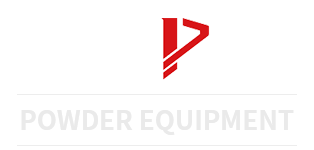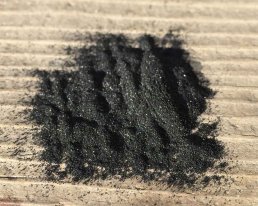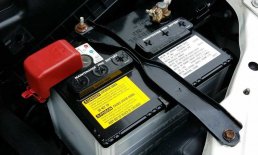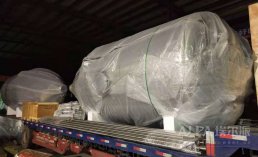Application and market of graphite electrodes
Graphite electrodes are mainly made of petroleum coke and needle coke as raw materials, coal tar pitch is used as a binder, and are made by calcining, batching, kneading, pressing, roasting, graphitization, and machining. It releases electric energy in the form of electric arc in an electric arc furnace. Conductor for thermal melting of the charge.
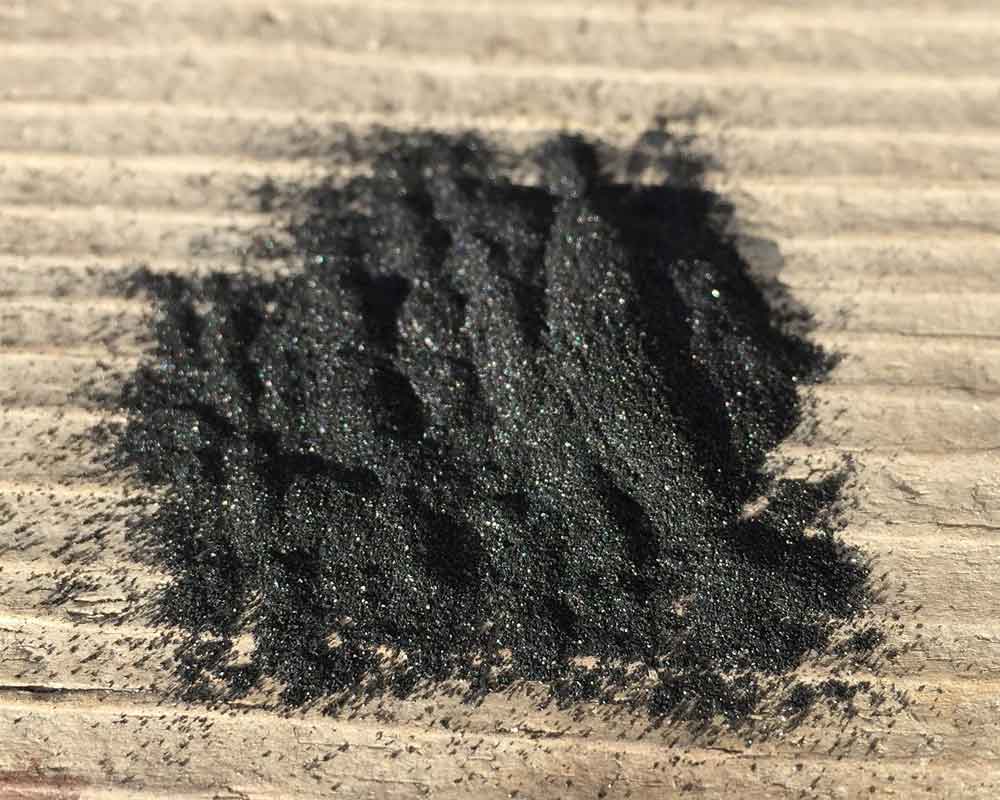
Classification of graphite electrodes
According to its quality index, it can be divided into ordinary power, high power and super high power. Graphite electrodes mainly include four types of ordinary power graphite electrodes, anti-oxidation coating graphite electrodes, high-power graphite electrodes and ultra-high-power graphite electrodes.
- Ordinary power graphite electrode
Graphite electrodes with current density lower than 17A/cm2 are allowed, which are mainly used for ordinary power electric furnaces for steelmaking, silicon making, and yellow phosphorus making.
- Anti-oxidation coating graphite electrode
A graphite electrode coated with an anti-oxidation protective layer (graphite electrode antioxidant) forms a protective layer that is both conductive and resistant to high-temperature oxidation, reducing electrode consumption (19%-50%) during steelmaking, and prolonging the use of electrodes Life span (22%~60%), reduce the power consumption of the electrode.
- High power graphite electrode
Graphite electrodes with a current density of 18-25A/cm2 are allowed, which are mainly used in high-power electric arc furnaces for steelmaking.
- Ultra-high power graphite electrode
Graphite electrodes with a current density greater than 25A/cm2 are allowed, and they are mainly used for ultra-high power steelmaking electric arc furnaces.
Characteristics of graphite electrodes
Advantages: good electrical conductivity, chemical stability, low electrode consumption, fast processing speed, good mechanical processing performance, high processing accuracy, small thermal deformation, light weight, easy surface treatment, high temperature resistance, high processing temperature, electrode bonding .
Disadvantages: The production cycle is long (the normal production cycle of graphite electrodes is generally about 90 days, and the production of electrode joints is four more processes than electrodes) and high cost.
There are five main elements to measure the performance of electrodes, which are processing speed, wear resistance, processed surface finish, processability and material cost. Copper electrodes are suitable for processing small and medium-sized workpieces with high surface roughness requirements; while graphite is suitable for processing various workpieces with low area roughness requirements, high electrode processing accuracy, high material unit prices, and high processing speeds.
Application of graphite electrode
- Application in die casting mold
In actual application, the processing time of graphite electrode is 1/2 of that of copper electrode with high precision, and the processing speed is 1.5 times that of copper electrode. According to statistics, if graphite electrodes are used for mold processing, small molds can save 15,000 yuan per set, medium-sized molds can save 50,000 yuan per set, and large-scale molds can save 85,000 yuan per set.
- Application in EDM
In the EDM process, tool click is the key determinant of the machining effect. Electrodes of different materials have a greater impact on processing efficiency, electrode loss, and surface quality. The high-performance graphite electrode has the unique advantages of small deformation, good thermal stability, high discharge efficiency, low loss, good conductivity, low density, no pollution to the environment, and reproducibility. It is an ideal electrode material. In Europe, more than 90% of the electrode materials used in EDM are graphite.
Graphite electrode market
According to the working current density, graphite electrodes are divided into ordinary graphite electrodes (RP), high-power graphite electrodes (HP), and ultra-high-power graphite electrodes (UHP). The main production and export countries of graphite electrodes abroad are the United States, Germany and Japan.
Graphite electrode raw materials include petroleum coke, coal pitch, calcined coke, needle coke and other major raw materials. The price of needle coke, the main raw material for graphite electrodes, rose the most, with a peak of 67% in one day. Needle coke accounts for 70% of the total cost of graphite electrodes, and ultra-high power graphite electrodes need to consume 1.05t needle coke. Needle coke can also be used in lithium batteries, nuclear power, aerospace and other fields.
Article source: China Powder Network
The jet mill effectively controls the particle density of battery raw materials and helps the development of the industry
Increasing the particle density of the positive electrode material can achieve the purpose of increasing the energy density of the battery. In this process, the jet mill can be said to have played a key role, because the particle density of the battery material depends on the particle density of the raw material. The jet mill can easily pulverize battery materials with high precision, and the pulverized product is fully compatible with its subsequent applications.
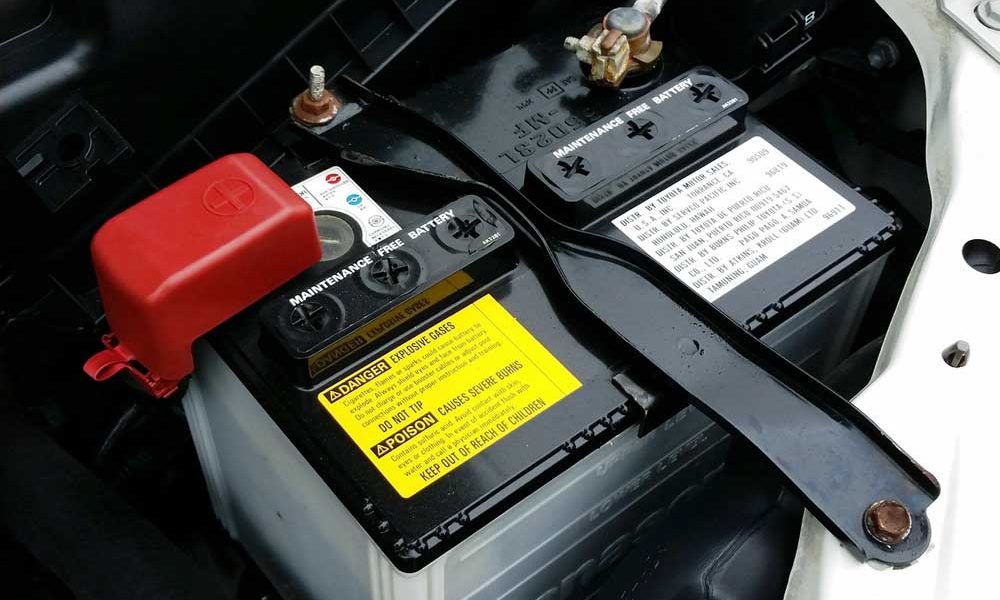
Jet mills have outstanding advantages in battery materials, especially in the preparation of cathode material raw materials, which are specifically manifested in the following aspects:
[High efficiency] The full use of jet energy can increase the crushing efficiency by 30% compared with the traditional jet mill. When used in conjunction with the classifier, the particle size distribution is ultra-narrow.
[Multi-purpose] One machine has multiple uses, it can be used as a grinder or as a classifier alone. The crushing particle size range is wide, and the particle size of the finished product can be adjusted arbitrarily within the range of 1~45μm.
[Environmental protection] Low temperature, no media crushing, to ensure the purity and physical and chemical properties of the product. The equipment runs under negative pressure, and there is no dust pollution.
[Small abrasion] The "jet mill + high-precision turbo classifier" can process ultra-fine powder with high purity and ultra-narrow, avoiding the abrasion of the crushing part of the "spray + horizontal classifier" and "fluidized bed + The abrasion of the “horizontal classifier” classification part is especially suitable for ultra-fine grinding of high-hardness and high-purity materials.
[Large output] When producing products with ultra-narrow particle size distribution, the yield is more than 1 times higher than that of traditional counter-jet and ordinary jet mills.
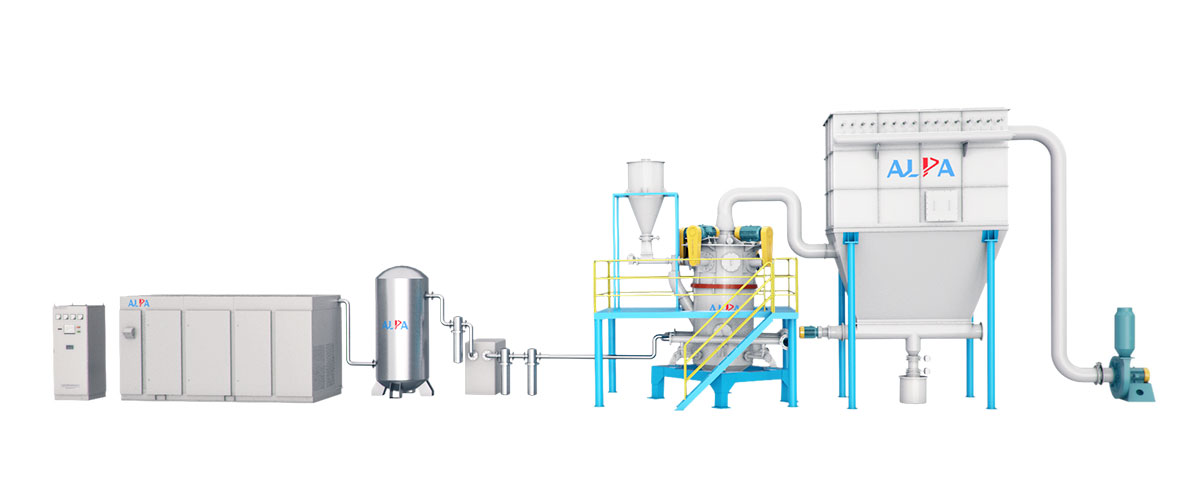
When the jet mill is working, the material is first fed into the silo, and the uniform feeder sends the material into the crushing chamber. The supersonic jet generated by the rapid acceleration of the compressed air through the nozzle forms a centripetal reverse jet flow field in the lower part of the crushing chamber. The material in the grinding chamber is fluidized under the effect of the difference. The accelerated material will be pulverized by violent impact, collision, shearing and crushing at the intersection of the multi-nozzle. The coarse particles in the flow field generated by the turbine are thrown near the side wall under the action of centrifugal force, and fall back to the crushing chamber with the stalled coarse powder to be crushed again, while the fine powder that meets the fineness requirements passes through the flow path of the classifier blade. It is transported to the cyclone separator through the exhaust pipe for collection as a finished product, a small amount of fine powder is further separated from the gas and solid by the bag collector, and the purified air is discharged by the induced draft fan.
Understand lithium battery anode material-spherical graphite
Graphite (referring to natural stone, the same below) is a non-metallic mineral resource. Graphite materials have various special properties such as high temperature resistance, electrical conductivity, thermal conductivity, lubrication, chemical stability, plasticity, and thermal shock resistance. Among them, spherical graphite is a high-end product in graphite and is used in strategic emerging industries such as new energy vehicles, energy storage, and environmental protection.
Spherical graphite is made of high-quality high-carbon natural flake graphite as raw material, and the graphite surface is modified by advanced processing technology to produce graphite products with different fineness and shape like oval spheres.

Indicators for measuring spherical graphite
- Physical performance index
Particle size (D50, μm), tap density (g/cm³), specific surface area (㎡/g), moisture (%), fixed carbon (%)
- Electrochemical performance index
Coulomb efficiency (%), charging capacity (mAh/g), cycle life (cycles)
Advantages and disadvantages of natural graphite
Natural graphite has the advantages of being used as a negative electrode material for lithium-ion batteries: wide sources, low price, low charge and discharge voltage platform, and high reversible capacity (theoretical value 372mAh/g).
However, there are many problems with graphite as the negative electrode material of the battery: poor compatibility with solvents; poor performance in high-current charging and discharging; during the first charge and discharge, the graphite layer is peeled off due to the co-embedding of solvent molecules, which leads to a reduction in electrode life.
Formation of spherical graphite
Through the spheroidization of flake graphite, the specific capacity (≥350mAh/g), the first cycle efficiency (≥85%) and cycle performance of the negative electrode material can be significantly improved.
- The size of the granularity
As a negative electrode material for lithium-ion batteries, the particle size D50 is most suitable between 16 and 18 μm. If the particle size is too small, the specific surface area will be larger, causing the negative electrode to consume a large amount of Li+ during the first cycle, thus forming a solid dielectric interfacial film, which is the first charge and discharge efficiency; The liquid contact area is small, which affects the specific capacity of the negative electrode.
- Spherical graphite production equipment
The production of spherical graphite has been industrialized. In industrial production, wind impact shaping machines are mainly used to spheroidize flake graphite. Among them, the airflow vortex pulverizer is a commonly used equipment. This method has less impurities during the spheroidization process, but its equipment is large in size, and the amount of graphite is large, and the yield is low, which is very limited in laboratory preparation.
Modification of spherical graphite
There are two main starting points for the modification:
1. Appropriately reduce the specific surface area of the stone mill to reduce the irreversible loss caused by the excessive stroke of the SEI film and the co-embedding of solvent molecules that cause the laminar peeling of graphite;
2. Introduce other metal elements or non-metals into graphite to increase the charge and discharge capacity of graphite.
- Coating method-improve the cycle performance of graphite
The "core-shell" model coating method uses graphite materials as the "core", and a "shell" of an amorphous carbon material is coated on its surface. The precursors of the commonly used amorphous carbon materials include phenolic resin, Epoxy resin and cracked carbon. The layer spacing of amorphous carbon materials is larger than that of graphite, which can improve the diffusion performance of lithium ions in it, which is equivalent to forming a buffer layer of lithium ions on the outer surface of graphite, thereby improving the high-current charge and discharge performance of graphite materials.
The coating method improves the cycle life of the battery, but the current coating process still has certain problems. The key problem to be solved at present is how to form a complete, uniform coating layer outside the graphite and well combined with the graphite.
- Doping method-increase the charge and discharge capacity of graphite
The introduction of certain metallic or non-metallic elements into carbon materials will result in changes in the carbon microstructure and electronic state, which will affect the lithium insertion behavior of carbon electrodes. At present, the most researched is the introduction of boron, silicon, and phosphorus into carbon materials. And other elements.
Other commonly used modification methods: surface oxidation, metal layer formation, mechanical grinding
Spherical graphite material has good electrical conductivity, high crystallinity, low cost, high theoretical lithium insertion capacity, low charge and discharge potential and flatness. It is an important part of lithium-ion battery anode material and is a cathode material for lithium-ion battery production at home and abroad. The replacement product. It has excellent electrical conductivity and chemical stability, high charge and discharge capacity, long cycle life, and environmental protection.
Reliable performance! ALPA cooperates again with rookies in the battery material industry
With the development of the global economy, the deepening of the energy crisis and the increasing awareness of environmental protection, new energy industries such as power batteries and other environmentally friendly and low-carbon energy industries have also developed rapidly. The rapid growth of the field of new energy vehicles has also led to the growth of demand for power batteries. The overall performance of batteries, environmental impact, and manufacturing costs are all key factors that determine the sound development of new energy vehicles and other related industries.
The goal of the battery material industry, especially the lithium battery industry, is to develop batteries with larger capacity, lighter weight, longer life, stronger functions, and shorter charging times. However, the lithium compounds used in lithium batteries have specific particle size distribution requirements. Ultra-fine lithium powder can be obtained through ultra-fine grinding technology to improve the performance of the battery, such as higher usable capacity, longer service life, and faster The charging rate and so on.
After continuous innovation and research and development, ALPA has a complete set of lithium battery positive and negative material processing solutions and equipment, including dust-free feeding, magnetic separation, ultra-fine grinding, grading, powder transportation, metering and packaging, automatic batching, intelligent control, etc. Integrated design of powder process technology. Among them, the MQW series fluidized bed jet mill is favored by users in the battery material industry. It has successively entered the purchasing ranks of battery materials and related industry giants such as a new material factory in Ningde, an energy material company in Xiamen, and an electric vehicle company in Shenzhen. Has reached a long-term strategic partnership with many companies.
In order to meet the development goal of the green era, ALPA and a battery material company in Sichuan cooperated again to provide it with MQW100T-3 fluidized bed jet mill.
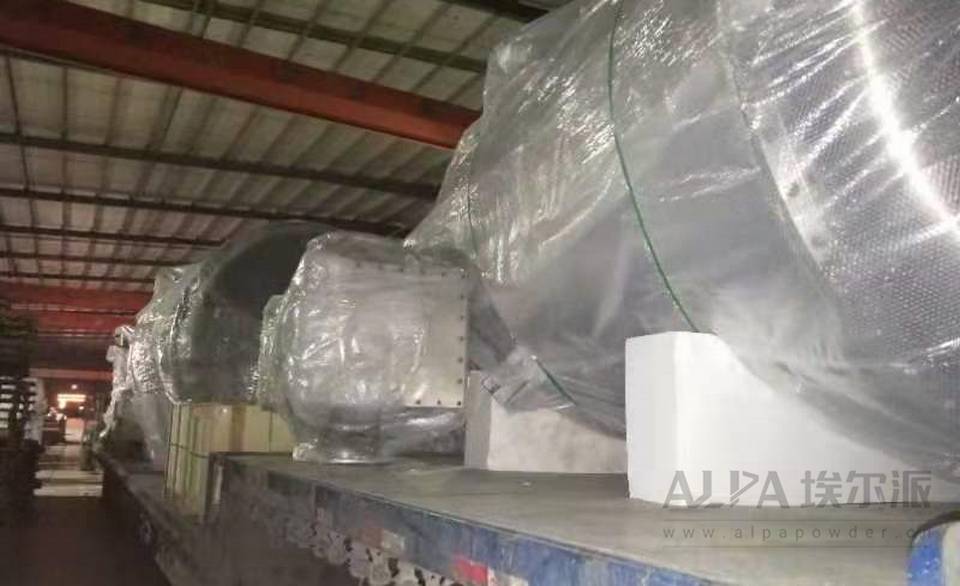
The single-machine capacity of this type of equipment is large-scale. The maximum linear speed of key components such as ceramic crushing discs and grading wheels exceeds 130 m/s. The single-machine crushing capacity of polycrystalline ternary materials exceeds 1000 kg/h, and energy consumption is saved by 50%. The finished product has good crushing particle shape, narrow particle size distribution, and high purity of the finished product. It is especially suitable for crushing materials with high hardness, high purity and high added value. The equipment can choose explosion-proof design according to the requirements to meet the crushing processing requirements of flammable, explosive and oxide materials.
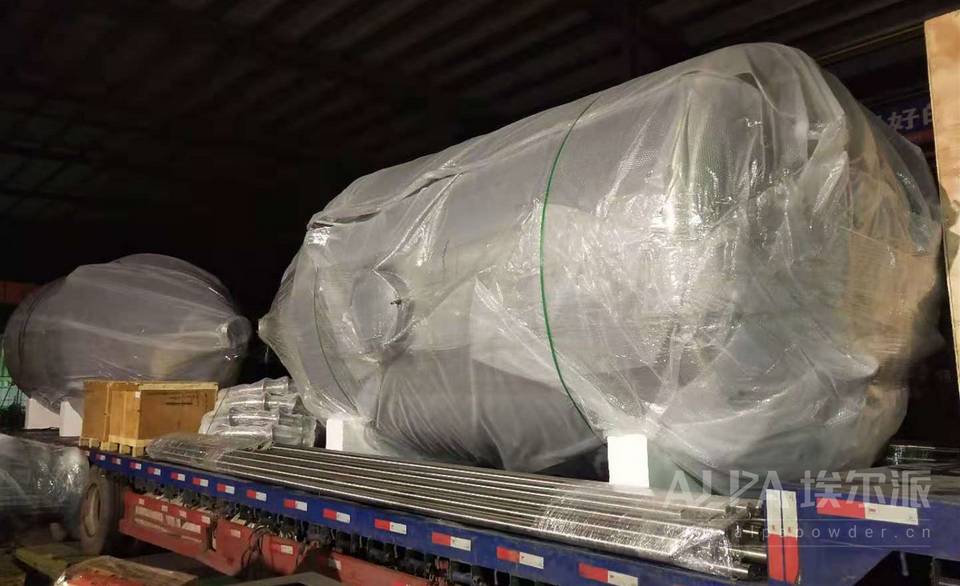
The MQW series fluidized bed jet mill adopts closed-loop inert gas protection to keep the air content in the system to a minimum, minimize water intake, and the water increase is less than 50PPM. The equipment lining can select ceramic materials such as alumina, zirconia, silicon carbide, silicon nitride, etc. according to the needs of battery products, to minimize the intake of impurities, and the intake of magnetic substances is less than 30PPB. Its automatic and intelligent design concept It also guarantees the consistency and repeatability of the product to the greatest extent.

MQW series-multi-rotor-system layout drawing
In order to reduce dependence on traditional petrochemical energy, energy conservation, emission reduction, and greenhouse effect, large-scale promotion and application of battery materials such as electric vehicles will become an inevitable trend, and the overall performance and manufacturing cost of batteries will also determine their commercial viability. Important indicators.
In the future, ALPA will continue to provide ultrafine pulverization technology equipment and project solutions for the battery material industry, helping new energy companies to develop a green lifestyle.
ALPA Knowledge Class: Modification of Montmorillonite and Its Application in Lithium Battery Solid Electrolyte
Montmorillonite is a typical water-bearing layered silicate mineral with a large specific surface area and strong ion exchange. It is widely used in the preparation of nanocomposites and is also the most commonly used clay mineral in the preparation of composite solid electrolytes. Through organic modification treatment, lithium salt modification treatment on montmorillonite, or by reducing the anisotropy of the electrolyte system, the composite solid electrolyte exhibits higher ionic conductivity.
Organic modification
Organic modification means that through organic intercalation, the compatibility of the smectite filler and the polymer matrix is improved, and the interval between the smectite layers can be enlarged, which is beneficial to the movement of ions between the layers and improves the performance of the electrolyte system.
Lithium-montmorillonite and lithium-montmorillonite intercalated with polyacrylonitrile were used as inorganic fillers to combine with polyacrylonitrile to prepare composite solid electrolytes. Under the same conditions, lithium-montmorillonite intercalated with polyacrylonitrile was used to prepare composite solid electrolytes. The ionic conductivity of the prepared composite solid electrolyte is one order of magnitude higher than the former.
Lithium salt modification
The lithium salt modification treatment is to insert lithium ions between the montmorillonite layers as a lithium source through ion exchange, so that the prepared composite solid electrolyte becomes a single-ion conductor, so as to prevent the movement of anions and cations in the electrolyte to form concentration polarization, resulting in degradation of battery performance .
The use of polyoxyethylene intercalation hectorite can prepare organic-inorganic mixed ion conductor materials. Within a certain temperature range, the ionic conductivity of polyoxyethylene/lithium-montmorillonite composites is much higher than that of lithium-montmorillonite Delithiation, which shows that the negatively charged silicate sheet makes the charge transport carrier in the electrolyte limited to cations.
Reduce the anisotropy of the electrolyte system
The unique layer structure of montmorillonite makes it easy to form a preferred orientation arrangement in the electrolyte system. When the non-conductive layer is perpendicular to the ion current path, the ionic conductivity of the composite electrolyte will be reduced to a certain extent. Therefore, some scholars have proposed that methods such as melt intercalation and ultrasonic stripping should be used to reduce the anisotropy of the electrolyte system to avoid negative effects on ion conductivity.
Compared with the solution intercalation method, the polymer/layered silicate composite prepared by the melt intercalation method can minimize the preferred orientation of the layered silicate, make the material have good isotropy, and avoid the removal of excess due to cleaning. The polymer affects the migration rate of lithium ions.
Intercalation or delaminating montmorillonite has a greater effect on the ionic conductivity of the electrolyte. The exfoliated clay can provide more mobile and conductive ions, and the cations in the intercalated clay will be trapped between the structural unit layers of the clay, resulting in a decrease in ionic conductivity.
Source: Powder Technology Network
Overview of graphite spheroidization technology for carbon anode used in lithium battery industry
- Lithium-ion battery anode materials include flake natural graphite, mesophase carbon microspheres and petroleum coke-based artificial graphite.
- Carbon material is currently the main negative electrode material used in lithium-ion batteries, and its performance affects the quality, cost and safety of lithium-ion batteries.
- How to improve the safety of lithium-ion batteries, especially how to develop negative electrode materials that meet the requirements of power batteries, is a concern for materials companies.
- In addition to raw materials and process formulas, which determine the performance of negative electrode materials, it is also one of the important factors to provide equipment and technologies such as carbon graphite crushing, spheroidization, shaping, and classification with stable performance and high efficiency and energy saving.
Milling stage:
Whether it is artificial graphite or natural graphite, it is crushed several times through several sets of CSM710 units (the naming method of each manufacturer is different) to become a D50:20μm powder. According to the different raw materials, the number of pulverization is different: For example, large scale natural graphite is generally crushed 4-6 times, and artificial graphite is generally crushed 1~3 times.
Spheroidization stage:
Generally, they tend to use a system of CSM410 and horizontal high-precision turbo classifiers for shaping. The classifier is used to remove fine powder produced by shaping in time. According to the different raw materials, the number of shaping is different. Natural graphite generally 8-12 times of shaping, artificial graphite generally 2 to 4 times of shaping.
(After long-term process practice, we have explored and optimized different spheroidizing process schemes for natural flake graphite and artificial graphite, for your reference.)
Natural flake graphite spheroidization process
Raw materials are milled by a single set of CSM710 special milling machine, particle size of raw materials is milled to a fine powder with particle size of D50: 21-23μm, which is convenient for the next process to be spherical. Through the CSM510 type spheroidizing machine equipped with the FW260 high efficiency classifier series unit process, the particles are prepared into spheroidized graphite particles with particle size of D50: 19-20μm, and CSM410 spheroidizing machine is equipped with FW230 high efficiency classifier series unit. Change the particle size to D50: 15-17μm potato-shaped graphite particles;
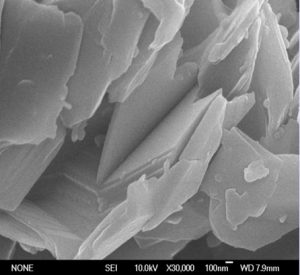
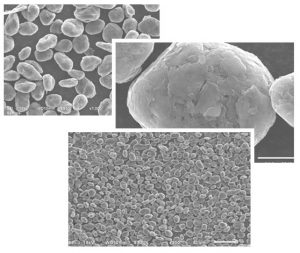
(The picture on the left is the raw material of flake graphite, and the picture on the right is the product after spheroidization of flake graphite)
Artificial graphite spheroidization process
Raw materials are uniformly sent to the CSM710 special mill single set series unit through the screw feed for ultra-fine grinding. Raw material particle size is milled to D50:23-25μm fine powder, which is convenient for the next process to be spheroidized. Through 3 sets of CSM510 type spheroidizing machines equipped with FW260 high-efficiency classifiers and several sets of series unit processes, the particles are prepared into graphite powder with particle size of D50: 19-21μm, and the required qualified potato-shaped balls are obtained through the special graphite surface modification and shaping equipment.


(The picture on the left is the raw material of artificial graphite carbon, and the picture on the right is the product after shaping the raw material of artificial graphite)
Comparison of milled particle size of graphite spheroidization technology

Graphite carbon raw material
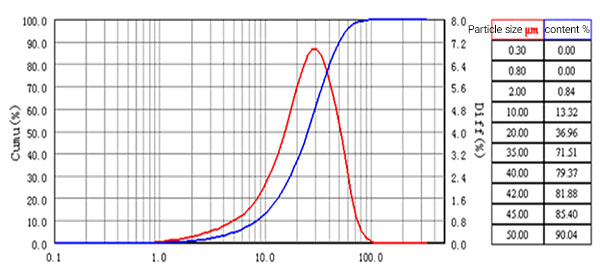
Milled by CSM710
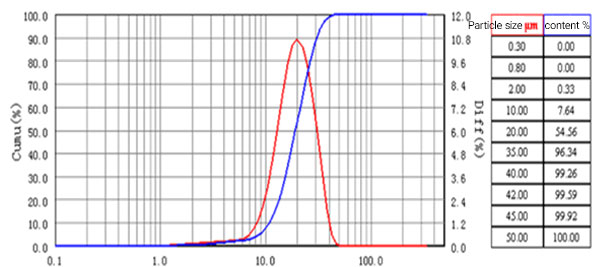
Spherical by CSM510

Shaping by CSM410
Meet at CIBF2021, ALPA is waiting for you!
On March 19th, the "14th China International Battery Technology Exchange/Exhibition (CIBF2021)" hosted by China Chemical and Physical Power Industry Association opened at Shenzhen Convention and Exhibition Center. ALPA representatives brought MQW40 fluidized bed jet mill and CSM510 -VD mechanical shredder will be exhibited, the booth is located at No. 7T062.
CIBF2021 is the largest exhibition event in the international battery industry. This year’s technical exchange will continue with the theme of "power batteries and energy storage batteries". The latest developments in AC power batteries, energy storage batteries and various materials will be highlighted in the past two years. my country has made a series of achievements in the field of power batteries for various passenger cars, new energy buses and logistics vehicles, and in the field of new energy energy storage.
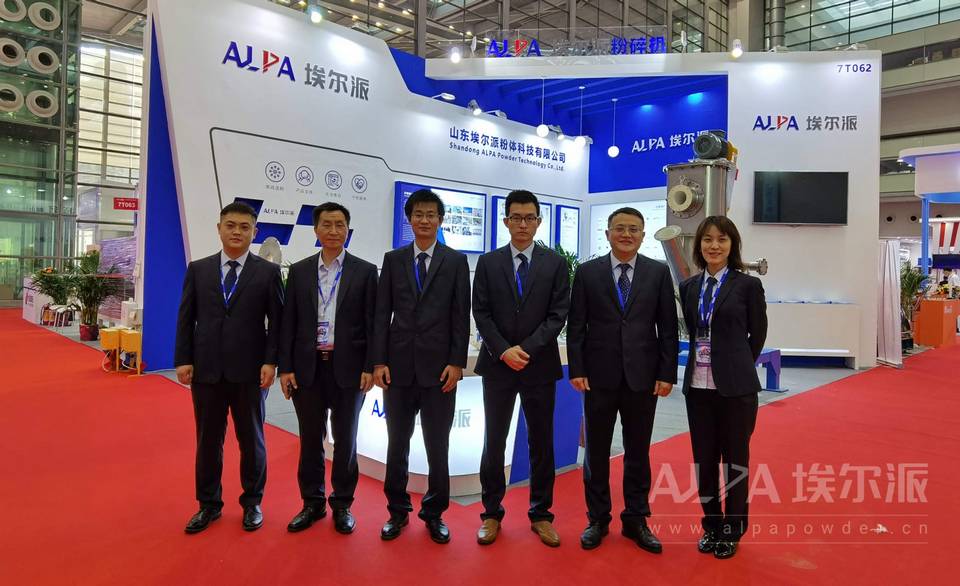
With the rapid development of mobile phones, computers, and new energy vehicles, the handling of battery materials has become the focus and difficulty of various companies. In the process of crushing raw materials, many materials are crushed and impurities, battery self-discharge capacity is reduced, energy consumption and production efficiency are not matched, product performance is poor and safety is poor, battery low voltage, etc. are all production problems faced by battery material companies.
As a well-known provider of ultrafine powder solutions in China, ALPA has developed a complete set of battery material processing solutions after years of research and development and innovation, which can provide cathode material crushing and grading, anode material crushing and shaping, battery fluid material crushing and grading, and The integrated design of the powder process technology meets the complex process requirements required for battery material processing.
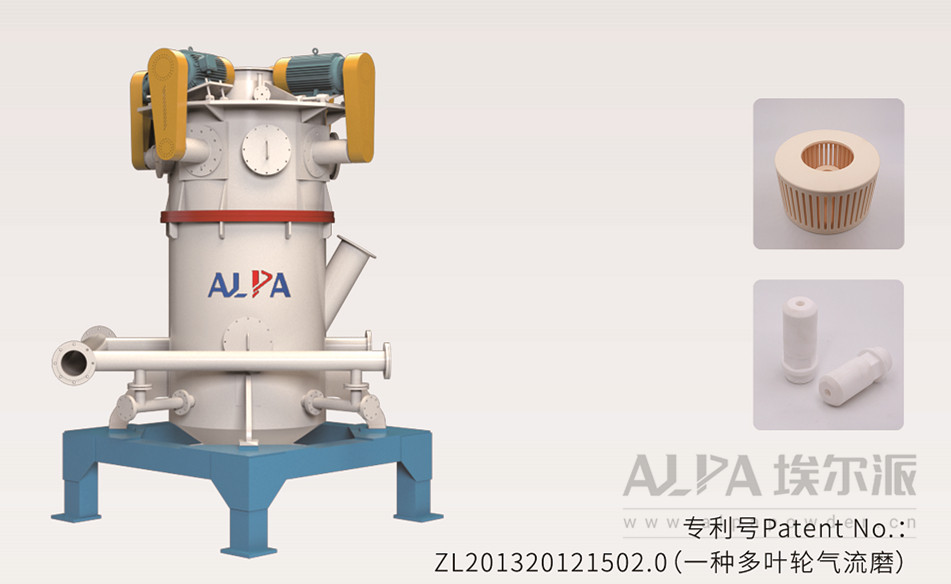
The MQW40 fluidized bed jet mill at the exhibition is an innovative high-precision jet mill with a built-in precision grading wheel. It has the advantages of good particle shape, narrow particle size distribution, high product purity, less dust, and low noise. It is suitable for heat sensitivity. The crushing of volatile and high value-added materials is often used in the crushing of single crystal ternary, lithium hydroxide, lithium carbonate, lithium iron phosphate, etc.
With advanced technology and excellent products, ALPA successfully reached a strategic cooperation with a battery material company in Shenzhen and provided it with a jet mill production line for battery material crushing. The company is the world’s largest manufacturer of lithium iron phosphate batteries with the largest production capacity, and is also the world’s leading provider of solar energy and energy storage solutions. When developing new products, it proactively contacted ALPA for procurement, and ALPA successfully entered the company’s high-quality supplier system.
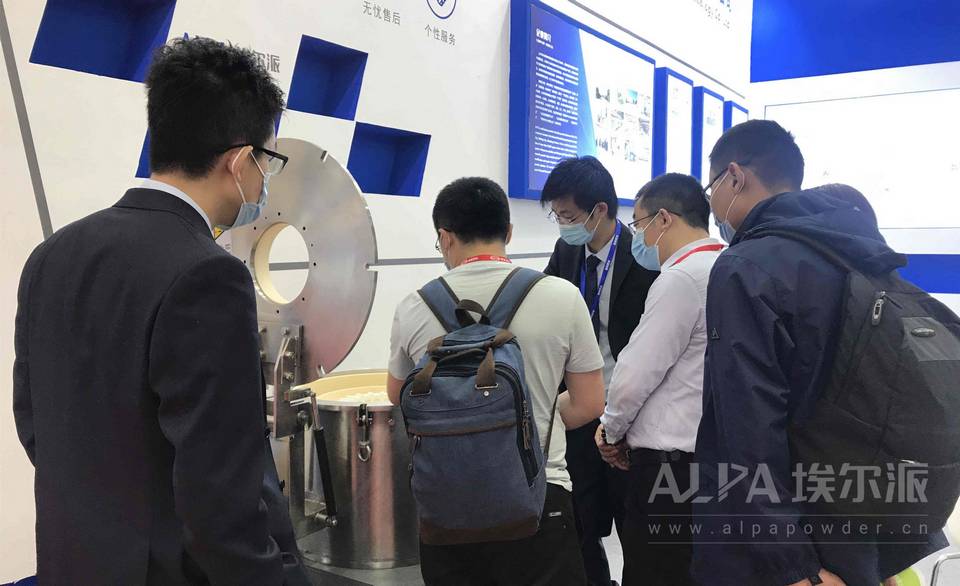
In addition, through day-to-day technological innovation, ALPA's ceramic molding technology has also been significantly improved. The maximum linear velocity of key components such as ceramic crushing disc and classifying wheel exceeds 130m/s. In the production process, the intake of magnetic substances is less than 30PPB, the moisture increase is less than 50PPM, and the filtration accuracy of the plastic sintered plate filtering and dust removal can reach 0.1μm. The hourly production capacity of ternary materials, lithium cobalt oxide, and lithium manganate is up to 1 ton, and the hourly production capacity of lithium iron phosphate and lithium carbonate is up to 3 tons, saving 50% of energy consumption.
For example, the CSM-510VD mechanical pulverizer at the exhibition is a high-efficiency pulverizer that integrates smashing and grading. The key components such as hammer head, gear ring, and grading wheel are all made of alumina, zirconia, silicon carbide and other ceramic materials. To meet the production requirements of high-purity materials, it is widely used in the crushing of single crystal ternary materials, ordinary ternary materials, silicon carbon anode, lithium manganate, lithium cobaltate, lithium iron phosphate and other materials.
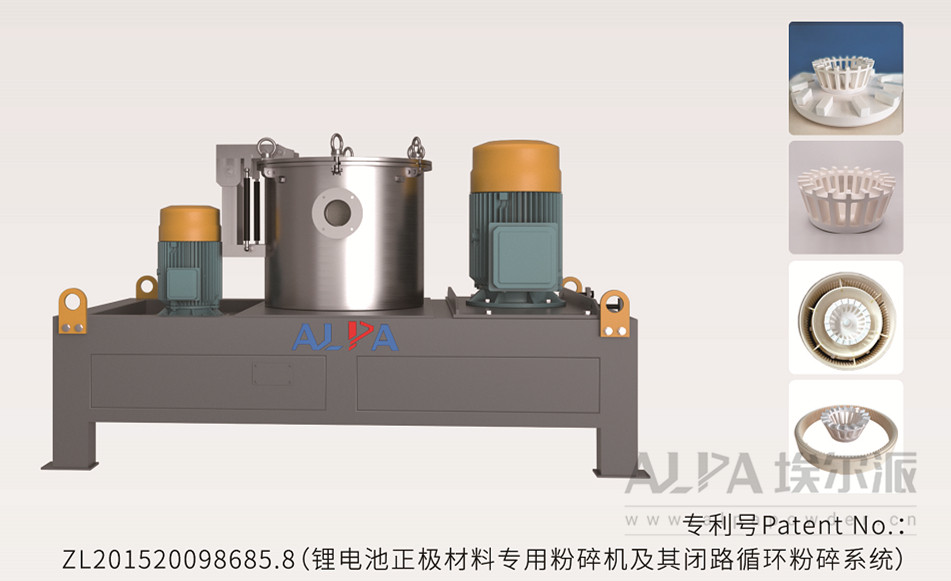
As a leader in the domestic ultrafine grinding industry, ALPA firmly believes in the power of quality and service, and has both soft and hard capabilities. It has gradually expanded the coverage of domestic and international markets. It has reached cooperation with giants in the battery material industry in many countries and has been highly praised by customers. .
Stepping on the stone leaves a mark, scratching the iron with marks. Development never stops, and backwardness will be eliminated. ALPA will definitely keep up with the pace of the times, perfectly integrate offline and online marketing networks, further expand brand strength and influence, and create brand-new results!
ALPA creates high-quality solutions to promote the healthy development of the battery material industry
With the progress of the times and the improvement of living standards, the development of mobile phones, computers, digital cameras, new energy vehicles and other industries is changing with each passing day, and the demand for lithium batteries is also increasing. Due to the technological innovation of lithium battery manufacturers, residents' demand for lithium battery products has also risen. As a leader in the powder industry, ALPA has reached cooperation with a number of well-known battery manufacturers and established a good supply and demand link with excellent crushing equipment and complete industry solutions.
Due to significant performance advantages, in recent years, the proportion of lithium batteries in the battery industry has continued to increase. China's lithium battery market is very broad, and more and more people are engaged in the lithium battery material industry. In the field of lithium-ion batteries, since the performance of the positive electrode material directly affects the performance of the lithium-ion battery, the cost of the positive electrode material determines the cost of the battery. It is for this reason that "the development of lithium-ion cathode materials has led the development of lithium-ion batteries".
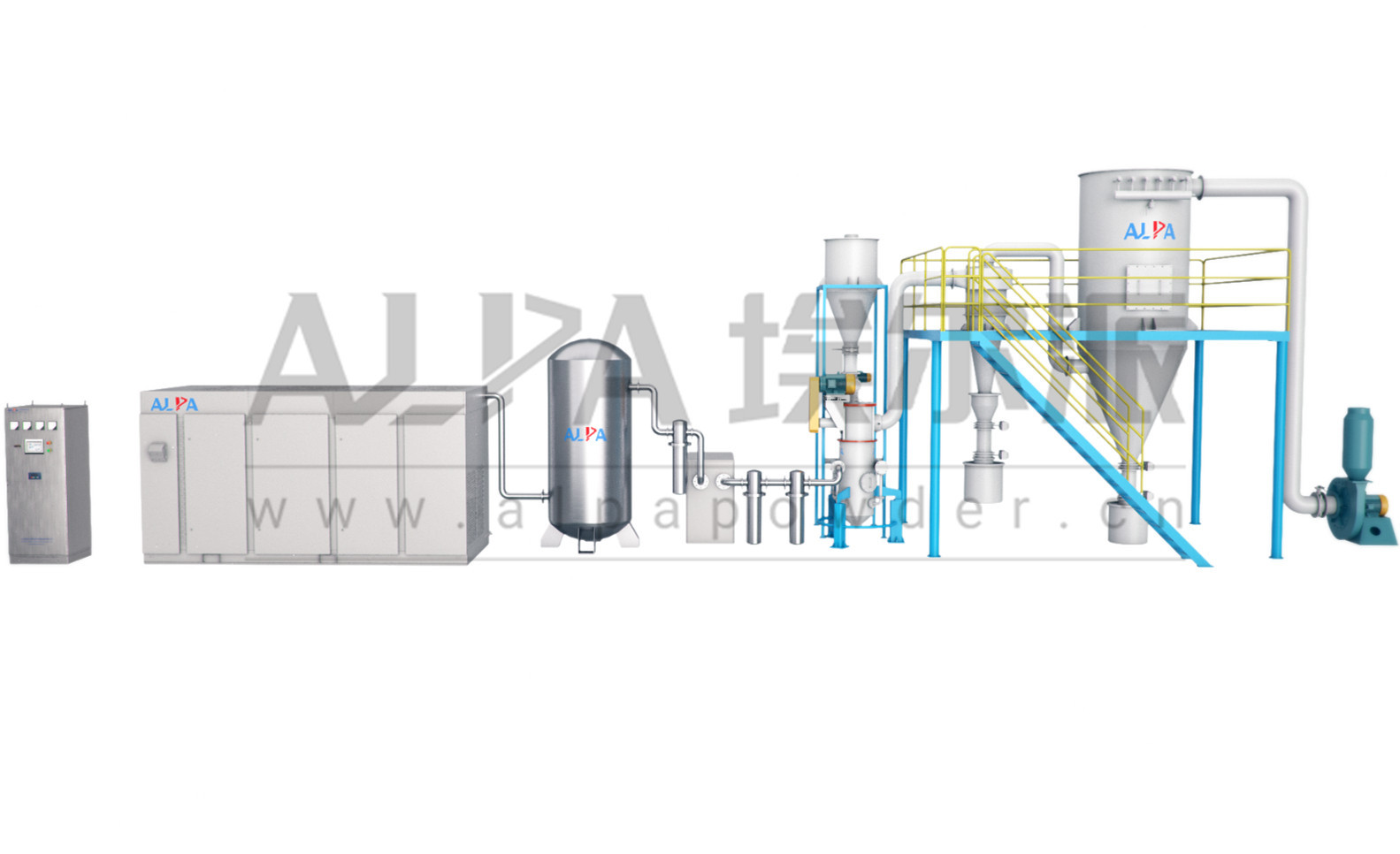
MQW series-single rotor-system layout drawing
The crushing of lithium battery cathode materials is a very critical process. Currently, commonly used equipment includes jet mills and mechanical mills. Air jet pulverization equipment is widely used in the pulverization of battery electrode materials. The battery electrode material needs to be processed into battery electrode powder by a jet mill, and the fineness and particle size of the powder affect the active quality of the electrode material. At present, the more commonly used cathode materials include lithium carbonate, lithium cobalt oxide, lithium manganate, lithium iron phosphate, ternary lithium, etc., and the more commonly used anode materials include graphite and carbon black.
The jet mill uses the kinetic energy of the high-speed airflow to make particles collide, rub, shear and smash each other. It has the characteristics of continuous production process and large capacity. But its shortcomings are also very obvious, that is, low energy utilization and high energy consumption. At present, ultra-fine pulverization technology should seek ways to reduce energy consumption, increase energy utilization, and improve electrode material processing technology to meet the trend and requirements of building an energy-saving and environmentally-friendly society.
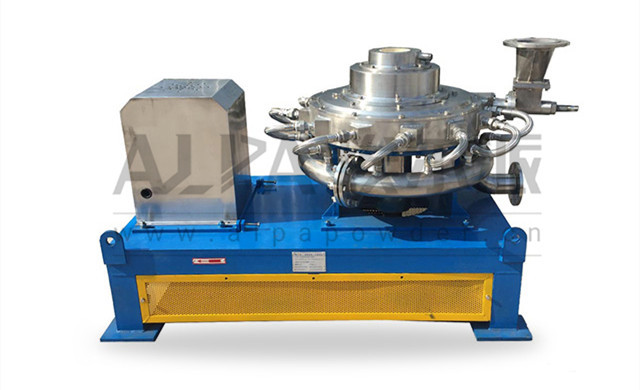
MQPW series
ALPA pays close attention to domestic market demand and technological development trends, continuously introduces mature technologies at home and abroad, selectively adopts and combines its own advantages to carry out pioneering and innovation. The MQW/MQPW model jet mill and CSM-VD series mechanical Widely acclaimed by users in the battery industry.
In addition, in the field of battery materials, ALPA can also provide crushing and shaping of anode materials, crushing and grading of battery liquid materials, and system integration, namely dust-free feeding, magnetic separation, powder transportation, crushing, ultra-fine grinding, metering and packaging, automatic batching, and intelligent control. Integrated design of other powder process technology. ALPA has accumulated a wealth of experience in long-term practice, and is committed to enabling users to maximize economic benefits with the best modern technology and the most economical and effective processing methods.
